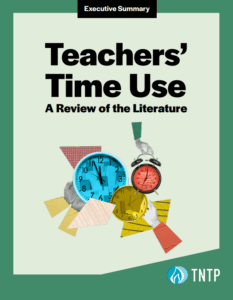Cami Anderson is the former superintendent of Newark Public Schools (NPS) in Newark, New Jersey. During her five year tenure as superintendent, Cami helped NPS reimagine the ways teachers were evaluated and paid in order to attract and keep great teachers in schools that need them most. We profiled these changes in Shortchanged, and since rolling out the new system, NPS has seen great results: the district retained 95 percent of their top teachers. We wanted to know how they did it.
Can you tell us a bit about your goals for Newark’s new teacher compensation system? How did you redesign the system to meet those goals?
We wanted to make sure our highest performers—especially those in hardest to staff schools and subjects—felt honored for their great work. The basic compensation model we came up with is if you are rated effective, you move up one step on the salary guide. If you’re highly effective, you also get a bonus that ranges from $5,000 to $10,000, depending on the type of school (is it high-needs, for example) and the subject you teach. If you’re partially effective, you can receive a step increase, but it is up to district administrative discretion. And if you’re ineffective, you receive no step increase that year.
How did you put that model into action?
We spent several years saying that, before we do anything to change how we pay teachers, we have to make sure we fix the evaluation process so people know what they're being evaluated on and feel like it’s fair, exciting, and represents what they want to be evaluated on. We had to make sure the system didn’t feel totally arbitrary: “This administrator likes me. This administrator doesn't.”
Teachers were involved in that process through focus groups, school‑based feedback sessions, and video sessions. Union folks and highly regarded teachers had a hand in what was in the evaluation rubric, how it was used, how it was rolled out, what the timeline was—and down the line even weighed in on all the letters and communications that went out.
Did you talk about how pay would eventually be attached to this new evaluation system?
Not explicitly, no. That wasn’t our initial goal. We felt like a prerequisite to having the conversation about teacher pay was an effective system for assessing how teachers were doing. Making our evaluation system transparent, fair, and evidence‑based with checks and balances was the most important thing, regardless of where we eventually landed with compensation.
How did you go from the improved evaluation system to shifting the model for teacher pay?
We had to put fairness first. Every school had a team charged with looking at patterns of how teachers were being evaluated at the school-level. We also had an advisory committee that was equal parts teachers and administrators. Their role was to look at patterns at the district-level, suggest changes in the system, and make sure there weren’t biases we were overlooking. Also, teachers could request a peer validation if they felt their performance rating wasn’t objective.
When we signed the new contract, we paid fierce attention to the details. We pulled together an implementation team that included department leadership in human resources, school management, strategy, finance, and communications. We all agreed on a series of goals with clear milestones, and we met every week to flag where we were not hitting milestones and where there were points of tension.
How long did it take to roll out the new system? A week, a month, a year?
A week—please! First, there were two years of getting the evaluation system right. Then there was a year of implementing the logistics of the new contract, which not only included major changes in pay, but also in school-based autonomy, turnarounds, and extended day. After that, it was constant upgrades, improvements, and solving problems we hadn’t thought of at the beginning. For example, the performance pay provision of the contract only applied to teachers at first. In order for other school-based staff like guidance counselors, school nurses, and teacher’s aides to be eligible, we had to redo their evaluation systems. That took time.
Did all that investment pay off?
The shifts we made were seismic. For one, the contract was ratified with an overwhelming majority. In my last two years, 95 percent of our highly effective teachers stayed in Newark, and close to 90 percent of our effective teachers stayed. About 65 percent of our partially effective teachers and 40 percent of our ineffective teachers stayed. That's the distribution you want to see.
A lot of the work you did in Newark was in the news. But the shift around compensation wasn't, and yet, this is a really big change. Can you talk a little about why that might be?
I think we did a lot of great things in Newark that were not fun to cover, from a news perspective. I do think it is interesting that in spite of all the headline‑grabbing actions that were taken by a very small group of people who purported to speak for all of Newark, 95 percent of our highly effective teachers stayed in Newark. That's a huge success, and I think it is because we approached the change compassionately.
Our mantra was, “We're people first and professionals second.” We undertook a major, systemic change and we knew we had to continually put ourselves in the shoes of teachers and remember, “Change is hard.” We thought about the human side of these changes and tried our best to build that into all of our work plans. We were also detail-oriented and thought through every step, rigorously identifying possible pitfalls.
My theory—though I don't have quantitative evidence for this—is that sweating the small stuff and paying attention to implementation was the key to getting compensation right in Newark. People felt like before, even though the compensation system was more traditional—and less high‑stakes in some ways—it lacked transparency, and rigor, and fairness. We changed that, and the good teachers felt like, “I'm actually being evaluated on the right things, and I'm being evaluated by people who know what they're doing. If I don't think that that's the case, I have somewhere to go, and someone will follow up.”
Do you think redesigning the compensation system was instrumental in helping you to achieve the larger goals you and your team had for Newark Public Schools?
No question. Though, of course, everyone wasn’t happy. Part of managing change effectively is recognizing many people benefit from a broken status quo and won't like giving it up. In particular, low-performing teachers really liked the previous system with no financial consequences. Many union officials also lamented a new approach where their influence and intimidation—because of the checks and balances—had limited impact.
But the fact of the matter is this: radically changing our evaluation and compensation systems was critical in moving our system from one that was very low quality to one that was starting to have some positive momentum. In the five years I served as superintendent, our lowest-performing schools made dramatic improvements and graduation rates went up by 12 percent. None of this would have been possible without improving teacher quality.








